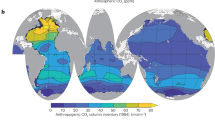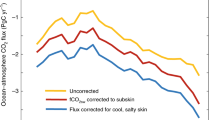Abstract
The release of fossil fuel CO2 to the atmosphere by human activity has been implicated as the predominant cause of recent global climate change1. The ocean plays a crucial role in mitigating the effects of this perturbation to the climate system, sequestering 20 to 35 per cent of anthropogenic CO2 emissions2,3,4. Although much progress has been made in recent years in understanding and quantifying this sink, considerable uncertainties remain as to the distribution of anthropogenic CO2 in the ocean, its rate of uptake over the industrial era, and the relative roles of the ocean and terrestrial biosphere in anthropogenic CO2 sequestration. Here we address these questions by presenting an observationally based reconstruction of the spatially resolved, time-dependent history of anthropogenic carbon in the ocean over the industrial era. Our approach is based on the recognition that the transport of tracers in the ocean can be described by a Green’s function, which we estimate from tracer data using a maximum entropy deconvolution technique. Our results indicate that ocean uptake of anthropogenic CO2 has increased sharply since the 1950s, with a small decline in the rate of increase in the last few decades. We estimate the inventory and uptake rate of anthropogenic CO2 in 2008 at 140 ± 25 Pg C and 2.3 ± 0.6 Pg C yr-1, respectively. We find that the Southern Ocean is the primary conduit by which this CO2 enters the ocean (contributing over 40 per cent of the anthropogenic CO2 inventory in the ocean in 2008). Our results also suggest that the terrestrial biosphere was a source of CO2 until the 1940s, subsequently turning into a sink. Taken over the entire industrial period, and accounting for uncertainties, we estimate that the terrestrial biosphere has been anywhere from neutral to a net source of CO2, contributing up to half as much CO2 as has been taken up by the ocean over the same period.
This is a preview of subscription content, access via your institution
Access options
Subscribe to this journal
Receive 51 print issues and online access
$199.00 per year
only $3.90 per issue
Buy this article
- Purchase on Springer Link
- Instant access to full article PDF
Prices may be subject to local taxes which are calculated during checkout



Similar content being viewed by others
References
Solomon, S. et al., eds. Climate Change 2007 — The Physical Science Basis (Cambridge Univ. Press, 2007)
Sabine, C. L. et al. The ocean sink for anthropogenic CO2 . Science 305, 367–371 (2004)
Houghton, R. A. Balancing the global carbon budget. Annu. Rev. Earth Planet. Sci. 35, 313–347 (2007)
Denman, K. L. et al. in Climate Change 2007 — The Physical Science Basis (eds Solomon, S. et al.) 499–587 (Cambridge Univ. Press, 2007)
Brewer, P. G. Direct measurements of the oceanic CO2 increase. Geophys. Res. Lett. 5, 997–1000 (1978)
Chen, C.-T. & Millero, F. J. Gradual increase of oceanic CO2 . Nature 277, 205–206 (1979)
Key, R. M. et al. A global ocean carbon climatology: results from GLODAP. Glob. Biogeochem. Cycles 18 10.1029/2004GB002247 (2004)
Gruber, N., Sarmiento, J. L. & Stocker, T. F. An improved method for detecting anthropogenic CO2 in the oceans. Glob. Biogeochem. Cycles 10, 809–837 (1996)
Wallace, D. W. R. Ocean measurements and models of carbon sources and sinks. Glob. Biogeochem. Cycles 15 3–10 10.1029/2000GB001354 (2001)
Matsumoto, K. & Gruber, N. How accurate is the estimation of anthropogenic carbon in the ocean? An evaluation of the ΔC* method. Glob. Biogeochem. Cycles 19 10.1029/2004GB002397 (2005)
Waugh, D. W., Hall, T. M., McNeil, B. I., Key, R. M. & Matear, R. J. Anthropogenic CO2 in the oceans estimated using transit-time distributions. Tellus B 58, 376–390 (2006)
Hall, T. M., Haine, T. W. N. & Waugh, D. W. Inferring the concentration of anthropogenic carbon in the ocean from tracers. Glob. Biogeochem. Cycles 16 10.1029/2001GB001835 (2002)
Sarmiento, J. L., Orr, J. C. & Siegenthaler, U. A perturbation simulation of CO2 uptake in an ocean general circulation model. J. Geophys. Res. 97, 3621–3645 (1992)
Tarantola, A. Inverse Problem Theory and Methods for Model Parameter Estimation (Society for Industrial and Applied Mathematics, 2005)
Tanhua, T. et al. Ventilation of the Arctic Ocean: mean ages and inventories of anthropogenic CO2 and CFC-11. J. Geophys. Res. 114 10.1029/2008JC004868 (2009)
Houghton, R. A. Carbon Flux to the Atmosphere from Land-Use Changes 1850-2005 (Carbon Dioxide Information Analysis Center, Oak Ridge National Laboratory, 2008) 〈http://cdiac.ornl.gov/trends/landuse/houghton/1850-2005.txt〉
Canadell, J. G. et al. Contributions to accelerating atmospheric CO2 growth from economic activity, carbon intensity and efficiency of natural sinks. Proc. Natl Acad. Sci. USA 104, 18866–18870 (2007)
Joos, F., Meyer, R., Bruno, M. & Leuenberger, M. The variability in the carbon sinks as reconstructed for the last 1000 years. Geophys. Res. Lett. 26, 1437–1440 (1999)
Le Quéré, C. et al. Saturation of the Southern Ocean CO2 sink due to recent climate change. Science 316 10.1126/science.1136188 (2007)
Lovenduski, N. S., Gruber, N., Doney, S. C. & Lima, I. D. Enhanced CO2 outgassing in the Southern Ocean from a positive phase of the Southern Annular Mode. Glob. Biogeochem. Cycles 21 10.1029/2006GB002900 (2007)
Böning, C. W., Dispert, A., Visbeck, M., Rintoul, S. & Schwarzkopf, F. U. Response of the Antarctic Circumpolar Current to recent climate change. Nature Geosci. 1, 864–869 (2008)
Zickfeld, K., Fyfe, J., Saenko, O. A., Eby, M. & Weaver, A. J. Response of the global carbon cycle to human-induced changes in the Southern Hemisphere winds. Geophys. Res. Lett. 34 10.1029/2006GL028797 (2007)
Mikaloff Fletcher, S. E. et al. Inverse estimates of anthropogenic CO2 uptake, transport, and storage by the ocean. Glob. Biogeochem. Cycles 20 10.1029/2005GB002530 (2006)
Matsumoto, K. et al. Evaluation of ocean carbon cycle models with data-based metrics. Geophys. Res. Lett. 31 10.1029/2003GL018970 (2004)
Cao, L. et al. The role of ocean transport in the uptake of anthropogenic CO2 . Biogeosciences 6, 375–390 (2009)
Waugh, D. W., Haine, T. W. & Hall, T. M. Transport times and anthropogenic carbon in the subpolar North Atlantic Ocean. Deep Sea Res. I 51, 1475–1491 (2004)
Khatiwala, S., Visbeck, M. & Schlosser, P. Age tracers in an ocean GCM. Deep Sea Res. I 48, 1423–1441 (2001)
Hall, T. M., Waugh, D. W., Haine, T. W. N., Robbins, P. E. & Khatiwala, S. Estimates of anthropogenic carbon in the Indian Ocean with allowance for mixing and time-varying air-sea CO2 disequilibrium. Glob. Biogeochem. Cycles 18 10.1029/2003GB002120 (2004)
Atmospheric Trace Gases: Carbon Dioxide. (Carbon Dioxide Information Analysis Center, Oak Ridge National Laboratory, 2009) 〈http://cdiac.ornl.gov/trends/co2〉
Boden, T. A., Marland, G. & Andres, R. J. Global, Regional, and National Fossil-fuel CO2 Emissions 10.3334/CDIAC/00001 (Carbon Dioxide Information Analysis Center, Oak Ridge National Laboratory, 2009); 〈http://cdiac.ornl.gov/trends/emis/tre_glob.html〉.
Locarnini, R. A. et al. World Ocean Atlas 2005 Vol. 1, Temperature (NOAA Atlas NESDIS 61, US Government Printing Office, 2006)
Antonov, J. I., Locarnini, R. A., Boyer, T. P., Mishonov, A. V. & Garcia, H. E. World Ocean Atlas 2005 Vol. 2, Salinity (NOAA Atlas NESDIS 62, US Government Printing Office, 2006)
Garcia, H. E., Locarnini, R. A., Boyer, T. P. & Antonov, J. I. World Ocean Atlas 2005 Vol. 3, Dissolved Oxygen, Apparent Oxygen Utilization, and Oxygen Saturation (NOAA Atlas NESDIS 63, US Government Printing Office, 2006)
Garcia, H. E., Locarnini, R. A., Boyer, T. P. & Antonov, J. I. World Ocean Atlas 2005 Vol. 4, Nutrients (Phosphate, Nitrate, Silicate) (NOAA Atlas NESDIS 64, US Government Printing Office, 2006)
Broecker, W. S. et al. How much deep water is formed in the Southern Ocean? J. Geophys. Res. 103, 15833–15844 (1998)
Walker, S. J., Weiss, R. F. & Salameh, P. K. Reconstructed histories of the annual mean atmospheric mole fractions for the halocarbons CFC11, CFC-12, CFC113 and carbon tetrachloride. J. Geophys. Res. 105, 14285–14296 (2000)
Smethie, W. M. & Fine, R. A. Rates of North Atlantic Deep Water formation calculated from chlorofluorocarbon inventories. Deep Sea Res. I 48, 189–215 (2001)
Rhein, M. et al. Labrador Sea Water: pathways, CFC inventory, and formation rates. J. Phys. Oceanogr. 32, 648–665 (2002)
Lo Monaco, C., Goyet, C., Metzl, N., Poisson, A. & Touratier, F. Distribution and inventory of anthropogenic CO2 in the Southern Ocean: comparison of three data-based methods. J. Geophys. Res. 110 10.1029/2004JC002571 (2005)
Sweeney, C. et al. Constraining global air-sea gas exchange for CO2 with recent bomb 14C measurements. Glob. Biogeochem. Cycles 21 10.1029/2006GB002784 (2007)
Takahashi, T. et al. Climatological mean and decadal change in surface ocean pCO2, and net sea-air CO2 flux over the global oceans. Deep Sea Res. II 56 10.1016/j.dsr2.2008.12.009 (2009)
Acknowledgements
This work was supported by US NSF grants OCE 06-23366 (to S.K. and T.H.) and OCE 07-26871 (to F.P.).
Author Contributions All authors contributed extensively to the work presented in this paper.
Author information
Authors and Affiliations
Corresponding author
Supplementary information
Supplementary Information
This file contains Supplementary Methods, Supplementary Figures S1-S3 with Legends and Supplementary References. (PDF 351 kb)
Rights and permissions
About this article
Cite this article
Khatiwala, S., Primeau, F. & Hall, T. Reconstruction of the history of anthropogenic CO2 concentrations in the ocean. Nature 462, 346–349 (2009). https://doi.org/10.1038/nature08526
Received:
Accepted:
Issue Date:
DOI: https://doi.org/10.1038/nature08526
This article is cited by
-
Synthesis of the land carbon fluxes of the Amazon region between 2010 and 2020
Communications Earth & Environment (2024)
-
Trends and variability in the ocean carbon sink
Nature Reviews Earth & Environment (2023)
-
Contribution of silica-scaled chrysophytes to ecosystems services: a review
Hydrobiologia (2023)
-
Ecosystem services provided by marine and freshwater phytoplankton
Hydrobiologia (2023)
-
Assessing carbon cycle projections from complex and simple models under SSP scenarios
Climatic Change (2023)
Comments
By submitting a comment you agree to abide by our Terms and Community Guidelines. If you find something abusive or that does not comply with our terms or guidelines please flag it as inappropriate.



